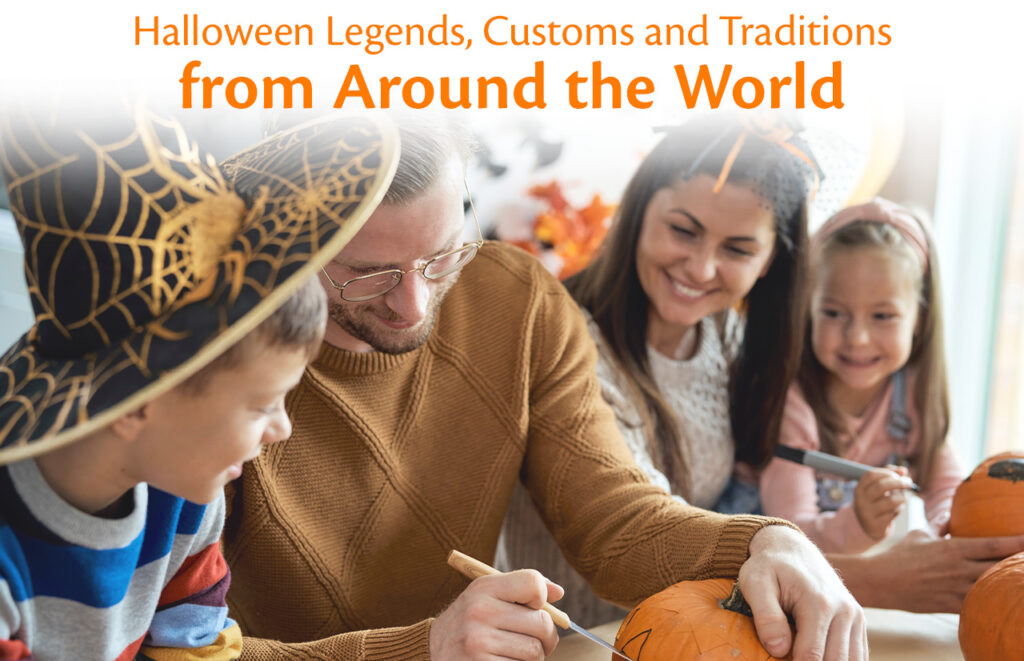It’s finally spooky season! The sensory treats of autumn are swirling all around us, delivering the distinctive flavors of Halloween time around every corner. From pumpkin spice lattes and costume planning to scary movies and graveyards of ghouls – there are so many things to love about Halloween. Do you have any favorites?
Based on where you live, how you grew up, and your own personal interests, you probably have specific traditions you enjoy around this time of year. Perhaps there are long-time traditions you picked up from childhood or maybe there are new rituals that have evolved out of your household’s love of October 31. Either way, there are certainly lots of things to look forward to as Halloween creeps up on us in 2023.
In today’s post we’re going to explore some fun and fascinating facts about this beloved holiday from right here in the United States. But we’re also going to take a more global look at things too, as we explore Halloween Legends, Customs and Traditions from Around the World.
Table of Contents
The Cultural Significance of Halloween
Halloween may not be that old, per se, but the seeds of Halloween certainly are. The deep roots are grounded in the ancient Celtic festival of Samhain (pronounced sah-win), a festival that began around the time that the first Celts arrived in Ireland, about 2,500 years ago. Each year on October 31, the rituals of Samhain were meant to mark the end-of-summer harvest and included immense bonfires and the donning of costumes to ward off any ghosts who might threaten future harvests.
Later, Christian holidays began to merge with the traditions of Samhain. All Soul’s Day was the first one, established by Pope Boniface IV and the Catholic church in A.D. 609. All Soul’s Day was recognized on November 2 as a time to honor the dead. Its traditions were very similar to those of Samhain, including bonfires and dressing up in costumes. Gradually this celebration expanded back into November 1 (All Saints Day) and finally the day before that, October 31, originally called All-Hallows Eve, and eventually Halloween.
The Halloween customs that most of us recognize today did not reach America until around the mid 1800s but they certainly caught on. The popularity of Halloween in the states has grown since its origins, but since it did not actually begin here, its influence globally has been even more far-reaching. But how everyone celebrates is not all the same. Let’s take a look.
Spooky Tales and Traditions from Other Cultures
If you live in the U.S., you are no doubt familiar with our Halloween traditions. Trick-or-treating, touring haunted houses, carving pumpkins, attending harvest events, parties and parades, dressing up in costumes and over-indulging in candy are some of the primary ones. These are the things we know and love. But once you venture outside of North America, you’ll be pleased to discover so many more colorful traditions and fascinating histories associated with Halloween.
MEXICO: el Dia de los Muertos (The Day of the Dead)
Halloween is celebrated in Mexico on October 31, called Dia de las Brujas (Day of the Witches) but it is mainly regarded as children’s event. There are pumpkin carvings and bonfires and people do sometimes dress up like zombies, but it largely overshadowed by the follow two calendar days: Dia de los Muertos (Day of the Dead).
Taking place each year on November 1 and 2, Day of the Dead is more culturally significant than Halloween in Mexico. So much so that it has expanded beyond Mexico and is also recognized within Latin American cultures and households all over the world.
Day of the Dead is a time for people to pay their respects to family members and friends who have moved beyond this planet and on to the spirit world. This important occasion is marked by reunions, decorating with marigolds, the creation of traditional foods and drinks, the making of sugar skulls (vividly decorated skull-shaped artwork comprised of compressed sugar and water), street parades, and the building of ofrendas – shrines to those who have passed.
To help celebrate el Dia de los Muertos, The Bradford Exchange offers a unique selection of Day of the Dead collectibles and tributes inspired by the traditional artwork and culturally relevant rituals of this annual event. We invite you to check them out!
Check Out – Top 5 Dia de los Muertos Collectibles for Your Home
IRELAND: The Legend of Stingy Jack
Ireland was the country primarily responsible for giving us Halloween, as mentioned earlier, but did you know the jack-o-lantern was also a gift from the Emerald Isle? The iconic carved and lighted pumpkin came from an Irish tall tale about a man called Stingy Jack.
Stingy Jack was a man who was true to his nickname. So much so that he invited the Devil to have a drink with him and tricked him into paying for it. Legend has it that Jack played many similar, successful tricks on the Devil over the years until his death.
One of his deals with the Devil prevented Jack’s soul from being taken to Hell, but of course, such an unsavory character would never be let into Heaven either. So, the Devil sent Stingy Jack out into the dark night to wander perpetually, with only the light of a single burning coal to guide his way. Jack put the coal into a hollowed-out turnip and has been roaming aimlessly ever since.
This legend caught on in Ireland and Scotland, inspiring people to create their own versions of Stingy Jack’s lantern by carving scary faces into turnips and potatoes and setting them out to scare the banished man away, calling them Jack of the Lantern, and eventually just jack-o-lantern. As this practice found its way across the world, and into the United States, people soon found that pumpkins, native to America, made the perfect jack-o-lanterns.
JAPAN: The Obon Festival
If you were a kid in Japan on Halloween and went trick-or-treating, you might get some strange looks. It’s not an honored tradition there. In fact, it’s considered in bad taste to show up at anyone’s door unannounced. Especially if you’re a stranger. But you can still dress up in costume!
Halloween in Japan is mostly celebrated with elaborate costumes and parades and parties. Especially street parties that historically go very late into the night and early morning hours. Probably the biggest party in Japan occurs in Tokyo, in the lively section of Shibuya, which some consider the heart and soul of the city.
There is a significant, spooky-adjacent celebration that takes place in Japan around 2 months prior to Halloween. It’s been recognized for over 500 years and really sort of overshadows October 31. Depending on the region of Japan you live in, Obon (or just Bon) is a festival that usually occurs between August 8 and September 7 each year. The date varies since it is based on the lunar calendar.
This 3-day event is comparable to the Day of the Dead in its purpose: a time to remember and honor deceased ancestors. It is believed that during Obon, the spirits of the dead return to visit the living. In addition to making alters, similar to the ofrendas in Mexico, floating lanterns are created and placed into rivers and lakes to help guide the spirits, and traditional dances called bon odori (literally bon dance) are performed to welcome the spirits of the dead.
ROMANIA: Beware the Vampire of Transylvania
In Romania, there are the typical Halloween costume parties and celebrations you might expect from a country so rich with stories, legends and famous characters. You are probably already aware of their most famous one. Do you recall Count Dracula?
Written at the turn of the 20th century, Bram Stoker’s Dracula (1897) tells the tale of a nobleman from Transylvania, in Central Romania, who happens to also be a vampire. The gothic novel became world famous and has boosted the tourism business in Romania through the years because of the allure of the vampire mythos. In fact, the Bran Castle in Transylvania is marketed as the home of the Count Dracula and hosts public tours, even though the description of the castle Stoker’s book does not necessarily reflect the Bran Castle’s design. Would you be up for a visit to Dracula’s castle?
CHINA: The Hungry Ghost Festival
Like Obon in Japan, the Hungry Ghost Festival is held in China during the same period: on the 15th day of the seventh month in the lunar calendar. It too is an occasion when dead ancestors come back to visit the living. It is also known as the Zhongyuan Festival in Taoism and the Yulanpen Festival in Buddhism.
The term “hungry ghost” comes from writings in Buddhism, Taoism and Chinese folk lore and is used to describe the condition of the lost spirits of the deceased, having an insatiable appetite or desire that cannot be quenched and their perpetual search for relief.
Because of this, typical Hungry Ghost Festival rituals include huge feasts and offerings of food and drink, floating lotus-shaped lanterns in the water to help guide lost spirits to the afterlife and the burning of josh money, also known as “hell money” to appease the spirits otherworldly monetary debts.
Trick or Treat: Fun Facts About Halloween
According to the National Retail Federation, and a survey conducted by Prosper Insights & Analytics, Halloween spending is expected to reach a record $12.2 billion for 2023. That’s a whole lot of candy!
Seriously though, there’s a lot more than just candy being purchased for the Halloween season. Special events, costumes and Halloween decorations are always generating demand and creating participation during September and October. Here are a few more statistics from the NRF about Halloween participation for 2023.
73% of people will participate in Halloween-themed activities this year, up from 69% last year. Here are how those activities break down:
68% will pass out candy to trick-or-treaters
53% will decorate their home or yard
50% will dress in a costume
32% will either throw a party or attend one
28% will take their children trick-or-treating
And speaking of candy… Americans historically purchase almost 600 million pounds of candy every year for Halloween. For perspective, that’s the equivalent to the weight of 6 Titanic ships. Now that IS a lot of candy! The crazy thing is an average trick-or-treater will consume over 3 pounds of that on their own. This is great news for dentists!
Now that you’re thoroughly in the mood for spooky season, why not let the spirit of Halloween guide you to the spooktacular Halloween decorations and collectibles available from The Bradford Exchange. They are not available anywhere else, and the selection is to die for.
We hope you and your family have a happy Halloween. And don’t forget to share your favorite Halloween traditions with us in the comments. We’d love to hear everything about them.
Halloween Legends, Customs and Traditions from Around the World by The Bradford Exchange
